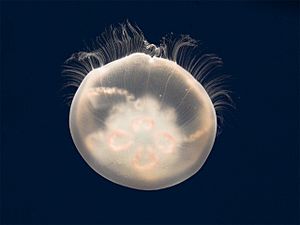Radiata facts for kids
Quick facts for kids RadiataTemporal range: Ediacaran – Recent
|
|
|---|---|
 |
|
| A moon jellyfish, Aurelia aurita | |
| Scientific classification | |
| Kingdom: | |
| Subkingdom: | |
| (unranked): |
Radiata
Linnaeus, 1758
|
| Phyla | |
|
|
The Radiata is a superphylum which includes both the echinoderms and the ctenophores. It is not part of the usual classification system, and is not used by all biologists.
The group includes the radially symmetric animals of the Eumetazoa. The echinoderms, however, are members of the Bilateria, because they exhibit bilateral symmetry in their developing stages. Their radial symmetry is secondary.
Thomas Cavalier-Smith in 1983 defined a subkingdom called Radiata consisting of the phyla Porifera, Myxozoa, Placozoa, Cnidaria and Ctenophora in Radiata, that is, all the animals that are not in Bilateria.
The Five Kingdom classification of Lynn Margulis and K.V. Schwartz keeps only Cnidaria and Ctenophora in Radiata.
Cladistic classifications do not recognize Radiata as a clade. The radiata, in this sense, are diploblastic, meaning they have two primary germ layers: endoderm and ectoderm. Cavalier-Smith's use of the term Radiata includes animals with a single germ layer such as sponges.
Although radial symmetry is usually given as a defining characteristic of radiates, a few members of the class Anthozoa, which are now considered as the most basal and oldest group of cnidarians, are actually bilaterally symmetric.
Newer research strongly indicates that bilateral symmetry evolved before the split between Cnidaria and Bilateria: the radially symmetrical cnidarians have evolved radial symmetry secondarily. This means the bilaterism in species like N. vectensis has a primary origin. Also the free-swimming planula larvae of cnidarians exhibit bilateral symmetry. Ctenophores show biradial symmetry.
See also
 In Spanish: Radiata para niños
In Spanish: Radiata para niños

